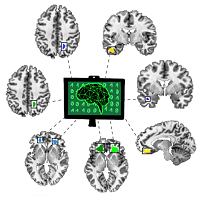Neuro Topics - Speech
SEARCH OTHER RESEARCH AREAS
July 18, 2024
In a first, neuroscientists have created a microscopic “brain thesaurus” that reflects how the meaning of words is represented. Using a novel technology to record the activity from single neurons in the human brain, the team was also able to predict the meaning of words heard in real-time speech. From Ziv Williams and Colleagues, co-first authors Mohsen Jamali and Benjamin Grannan.
Original article in: Nature >
February 8, 2024
Researchers from Massachusetts General Hospital demonstrate how neurons in the human brain work together to allow people to think about what words they want to say and then produce them aloud through speech. The findings provide a detailed map of how speech sounds such as consonants and vowels are represented in the brain well before they are even spoken and how they are strung together during language production.
Original article in: Nature >
November 13, 2023
Harvard Gazette article on new research from an international team co-led by Bruce Fischl (MGH/Harvard) and Patrick Hoff (Mount Sinai School of Medicine). By combining different noninvasive imaging techniques such as MRI, optical coherence tomography, and light-sheet fluorescence microscopy, their team created a comprehensive cellular atlas of a region of the human brain known as Broca’s area, critical for producing language.
Original article in: Science Advances >
August 1, 2022
HMS News article profiling the research of Bruce Bean and Clifford Woolf, who are studying how CBD inhibits pain-sensing neurons in order to develop more effective pain medicines.
August 1, 2022
Harvard Gazette article on new research from Samuel Mehr and colleagues, co-first authors Courtney Hilton and Cody J. Moser. They studied 21 cultures, from San Diego to East Africa and found striking similarities in infant-directed speech and song.
Original article in: Nature Human Behavior >
September 21, 2021
Based on a 5-year longitudinal neuroimaging project starting in infancy, Xi Yu and Nadine Gaab share new research demonstrating that functional connectivity in infancy can predict subsequent individual differences in language and foundational literacy abilities at school-age. These results highlight the importance of the early brain function organization as a neural scaffold for long-term development of complex, high-order cognitive functions.
Original article in: Cerebral Cortex >
September 14, 2021
Round up of awards and honors earned by the HBI community.
October 14, 2020
Davide Valeriani shares new research from the Dystonia and Speech Motor Control Laboratory on the development of DystoniaNet, a 3D convolutional neural network capable of diagnosing dystonia from raw structural MRI data.
Original article in: PNAS >
October 6, 2020
Round up of awards and honors earned by the HBI community.








